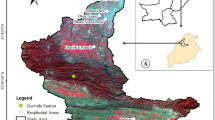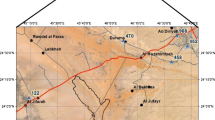Abstract
With many countries facing water scarcity and the demand for water ever-increasing, more people are turning to rainwater harvesting (RWH) as a feasible way of supplementing supply. However, the success of RWH systems depends on several factors, including rainfall, catchment characteristics and socio-economic factors. Hence it is essential to carry out location-specific studies to evaluate the potential of RWH in a particular area. This study sought to assess the influence of seasonal rainfall and climate change, and socio-economic constraints on RWH in the City of Johannesburg. A GIS-based MCDA was run to estimate RWH suitable sites as influenced by various socio-economic factors. The RWH suitability map shows that at least 50% of the city is suitable for RWH. These, together with climate data was embedded into a rainfall-runoff model developed in HEC-HMS to simulate runoff volumes up to the year 2050. The Deficit and Constant loss method was employed to calculate infiltration losses. After calibration, the model results were within acceptable limits (R2 = 0.68 and 0.79). The rainfall-runoff simulation results show that high runoff volumes are received during the wet season, which is more than double the non-potable water demand. These results indicate that, with ample storage, RWH systems are feasible despite the rainfall seasonality. Therefore, it is recommended to invest in diverse and multipurpose storage to improve RWH reliability.





Similar content being viewed by others
Data Availability
Authors agree with data transparency and undertake to provide any required data and material.
References
Akinseye SA, Harmse JT (2014) Water quality in two catchment areas: a case study of Crocodile (West) and Berg Catchment areas. Water Pract Technol. https://doi.org/10.2166/wpt.2014.059
Aladenola OO, Adeboye OB (2010) Assessing the potential for rainwater harvesting. Water Resour Manag 24:2129–2137. https://doi.org/10.1007/s11269-009-9542-y
Bailey A (2012) Water Resources of South Africa, 2012 Study - About WR 2012. http://waterresourceswr2012.co.za/about/. Accessed 18 May 2019
Baiyegunhi LJS (2015) Determinants of rainwater harvesting technology (RWHT) adoption for home gardening in Msinga, KwaZulu-Natal, South Africa. Water SA. https://doi.org/10.4314/wsa.v41i1.6
Balogun II, Sojobi AO, Oyedepo BO, Sojobi O (2016) Assessment of rainfall variability, rainwater harvesting potential and storage requirements in Odeda Local Government Area of Ogun State in South-western Nigeria. Cogent Environ Sci 2:1138597. https://doi.org/10.1080/23311843.2016.1138597
Baumbach T, Burckhard SR, Kant JM (2015) Watershed modeling using arc hydro tools. Geo HMS, and HEC-HMS. Civ Environ Eng Fac Publ 1–35
Brown S (2016) A guide to types of non potable water and the potential for reuse in urban systems. In: Brown S, McIvor K, Snyder EH (eds) Sowing seeds in the city. Springer, Dordrecht
Campisano A, Butler D, Ward S et al (2017) Urban rainwater harvesting systems: research, implementation and future perspectives. Water Res 115:195–209. https://doi.org/10.1016/j.watres.2017.02.056
Chai T, Draxler RR (2014) Root mean square error (RMSE) or mean absolute error (MAE)? Arguments against avoiding RMSE in the literature. Geosci Model Dev 7:1247–1250. https://doi.org/10.5194/gmd-7-1247-2014
City of CapeTown (2020) Household water use guide. Cape Town
Cook S, Sharma AK, Gurung TR (2014) Evaluation of alternative water sources for commercial buildings: a case study in Brisbane, Australia. Resour Conserv Recycl 89:86–93. https://doi.org/10.1016/j.resconrec.2014.05.003
Cunderlik JM, Simonovic SP (2004) Calibration, verification and sensitivity analysis of HEC-HMS Model. Ontario
De Silva MMGT, Weerakoon SB, Herath S (2014) Modeling of event and continuous flow hydrographs with HEC-HMS: Case study in the Kelani River basin, Sri Lanka. J Hydrol Eng 19:800–806. https://doi.org/10.1061/(ASCE)HE.1943-5584.0000846
Fang GH, Yang J, Chen YN, Zammit C (2015) Comparing bias correction methods in downscaling meteorological variables for a hydrologic impact study in an arid area in China. Hydrol Earth Syst Sci 19:2547–2559. https://doi.org/10.5194/hess-19-2547-2015
FAO (2014) Feasibility study of rainwater harvesting for agriculture in the Caribbean subregion. 74
FAO (2015) Water and People: whose right is it? http://www.fao.org/3/y4555e/y4555e00.htm. Accessed 1 Jul 2020
Feizizadeh B, Jankowski P, Blaschke T (2014) A GIS based spatially-explicit sensitivity and uncertainty analysis approach for multi-criteria decision analysis. Comput Geosci 64:81–95. https://doi.org/10.1016/j.cageo.2013.11.009
Finn A (2015) A National Minimum Wage in the context of South African Labour Market. Johannesburg
Fisher-Jeffes LN, Armitage NP, Carden K (2017) The viability of domestic rainwater harvesting in the residential areas of the liesbeek river catchment, Cape Town. Water SA 43:81–90. https://doi.org/10.4314/wsa.v43i1.11
Hameed HM (2017) Estimating the effect of urban growth on annual runoff volume using GIS in the Erbil Sub-Basin of the Kurdistan Region of Iraq. Hydrology. https://doi.org/10.3390/hydrology4010012
Jamali B, Bach PM, Deletic A (2020) Rainwater harvesting for urban flood management—an integrated modelling framework. Water Res 171:115372. https://doi.org/10.1016/j.watres.2019.115372
Johannesburg Water (2016) Integrated Annual Report 2015/2016
Johannesburg Water (2017) Mid-Year Report 2017/18
Johannesburg Water (2020) Active Leak Detection Programme | Johannesburg Water. In: https://johannesburgwater.co.za/. https://johannesburgwater.co.za/active-leak-detection-programme/. Accessed 30 Jun 2020
Karlsson IB, Sonnenborg TO, Refsgaard JC et al (2016) Combined effects of climate models, hydrological model structures and land use scenarios on hydrological impacts of climate change. J Hydrol 535:301–317. https://doi.org/10.1016/j.jhydrol.2016.01.069
Khan Z, Alim MA, Rahman MM, Rahman A (2021) A continental scale evaluation of rainwater harvesting in Australia. Resour Conserv Recycl 167:105378. https://doi.org/10.1016/j.resconrec.2020.105378
Kiesel J, Gericke A, Rathjens H et al (2019) Climate change impacts on ecologically relevant hydrological indicators in three catchments in three European ecoregions. Ecol Eng 127:404–416. https://doi.org/10.1016/j.ecoleng.2018.12.019
Kuller M, Dolman NJ, Vreeburg JHG, Spiller M (2017) Scenario analysis of rainwater harvesting and use on a large scale–assessment of runoff, storage and economic performance for the case study Amsterdam Airport Schiphol. Urban Water J 14:237–246. https://doi.org/10.1080/1573062X.2015.1086007
Lavee H, Poesen J, Yair A (1997) Evidence of high efficiency water-harvesting by ancient farmers in the Negev Desert, Israel. J Arid Environ 35:341–348. https://doi.org/10.1006/jare.1996.0170
Li Z (2014) Watershed modeling using arc hydro based on DEMs: a case study in Jackpine watershed. Environ Syst Res 3:11. https://doi.org/10.1186/2193-2697-3-11
Loux J, Winer-Skonovd R, Gellerman E (2012) Evaluation of combined rainwater and greywater systems for multiple development types in Mediterranean climates. J Water Sustain 1:55–77
Luo M, Liu T, Meng F et al (2018) Comparing bias correction methods used in downscaling precipitation and temperature from regional climate models: a case study from the Kaidu River Basin in Western China. Water (switzerland). https://doi.org/10.3390/w10081046
Moriasi DN, Arnold JG, Van Liew MW, et al (2007) Model evaluation guidelines for systematic quantification of accuracy in watershed simulations
Mwenge Kahinda J, Taigbenu AE (2011) Rainwater harvesting in South Africa: challenges and opportunities. Phys Chem Earth. https://doi.org/10.1016/j.pce.2011.08.011
Mwenge Kahinda J, Taigbenu AE, Sejamoholo BBP et al (2009) A GIS-based decision support system for rainwater harvesting (RHADESS). Phys Chem Earth. https://doi.org/10.1016/j.pce.2009.06.011
Ndeketeya A, Dundu M (2019) Maximising the benefits of rainwater harvesting technology towards sustainability in urban areas of South Africa: a case study. Urban Water J. https://doi.org/10.1080/1573062X.2019.1637907
Nel JL, Colvin C, Le Maitre D, et al (2013) Defining South Africa’s Water Source Areas. 32
Nel N, Jacobs HE, Loubser C, Du Plessis KJ (2017) Supplementary household water sources to augment potable municipal supply in South Africa. Water SA. https://doi.org/10.4314/wsa.v43i4.03
Ngigi SN (2003) What is the limit of up-scaling rainwater harvesting in a river basin? Phys Chem Earth 28:943–956. https://doi.org/10.1016/j.pce.2003.08.015
Onderka M, Pecho J, Nejedlík P (2020) On how rainfall characteristics affect the sizing of rain barrels in Slovakia. J Hydrol Reg Stud 32:100747. https://doi.org/10.1016/j.ejrh.2020.100747
Osei MA, Amekudzi LK, Wemegah DD et al (2019) The impact of climate and land-use changes on the hydrological processes of Owabi catchment from SWAT analysis. J Hydrol Reg Stud. https://doi.org/10.1016/j.ejrh.2019.100620
Pandy WR, Rogerson CM (2019) Urban tourism and climate change: Risk perceptions of business tourism stakeholders in Johannesburg, South Africa. Urbani Izziv 30:225–243
Pappas EA, Smith DR, Huang C et al (2008) Impervious surface impacts to runoff and sediment discharge under laboratory rainfall simulation. CATENA 72:146–152. https://doi.org/10.1016/j.catena.2007.05.001
Rathjens H, Bieger K, Srinivasan R, et al (2016) CMhyd User Manual Documentation for preparing simulated climate change data for hydrologic impact studies
Reynaud A, Pons M, Pesado C et al (2018) Household water demand in Andorra: impact of individual metering and seasonality. Water 10:321. https://doi.org/10.3390/w10030321
Roffe SJ, Fitchett JM, Curtis CJ (2019) Classifying and mapping rainfall seasonality in South Africa: a review. South African Geogr J 101:158–174. https://doi.org/10.1080/03736245.2019.1573151
Roffe SJ, Fitchett JM, Curtis CJ (2021) Investigating changes in rainfall seasonality across South Africa: 1987–2016. Int J Climatol 41:E2031–E2050. https://doi.org/10.1002/joc.6830
Shrestha M, Acharya SC, Shrestha PK (2017) Bias correction of climate models for hydrological modelling—are simple methods still useful? Meteorol Appl 24:531–539. https://doi.org/10.1002/met.1655
Shuster WD, Bonta J, Thurston H et al (2005) Impacts of impervious surface on watershed hydrology: a review. Urban Water J 2:263–275. https://doi.org/10.1080/15730620500386529
Siraj N, Beyene F (2017) Determinants of adoption of rainwater harvesting technology: the case of Gursum District. Soc Sci 6:174–181. https://doi.org/10.11648/j.ss.20170606.15
Tian P, Lu H, Feng W et al (2019) Large decrease in streamflow and sediment load of Qinghai-Tibetan Plateau driven by future climate change: a case study in Lhasa River Basin. CATENA 187:104340. https://doi.org/10.1016/j.catena.2019.104340
US Army Corps of Engineers (2013) HEC-GeoHMS Geospatial Hydrologic Modeling Extension User ’ s Manual. Davis, CA
US Army Corps of Engineers (2018) Hydrologic Modeling System HEC-HMS, Hydrologic Modeling System HEC-HMS, User’s Manual. Version 4.3. Hydrologic Engineering Centre. Hydrol Eng Cent 640. https://doi.org/10.1016/j.matchemphys.2008.05.088
Wen S, Su B, Wang Y et al (2020) Comprehensive evaluation of hydrological models for climate change impact assessment in the Upper Yangtze River Basin, China. Clim Change 163:1207–1226. https://doi.org/10.1007/s10584-020-02929-6
WHO (2016) What is the minimum quantity of water needed? In: World Heal. Organ. http://www.who.int/water_sanitation_health/emergencies/qa/emergencies_qa5/en/. Accessed 1 Jul 2020
Zelelew DG, Langon S (2020) Selection of appropriate loss methods in HEC-HMS model and determination of the derived values of the sensitive parameters for un-gauged catchments in Northern Ethiopia. Int J River Basin Manag 18:127–135. https://doi.org/10.1080/15715124.2019.1672701
Zhang B, Shrestha NK, Daggupati P et al (2018) Quantifying the impacts of climate change on streamflow dynamics of two major rivers of the Northern Lake Erie basin in Canada. Sustain. https://doi.org/10.3390/su10082897
Acknowledgements
The authors would like to thank the University of Johannesburg for the support.
Funding
No funding was received to assist with the preparation of this manuscript.
Author information
Authors and Affiliations
Contributions
Both authors contributed to the study. Annah A. Ndeketeya wrote the first draft of the manuscript, and Morgan M. Dundu commented and approved the final manuscript.
Corresponding author
Ethics declarations
Ethical Approval
The authors undertake that this article has not been published in any other journal and that no plagiarism has occurred.
Consent to Participate
The authors agree to participate in the journal.
Consent to Publish
The authors agree to publish in the journal.
Conflicts of interest
The authors have no relevant financial or non-financial interests to disclose.
Additional information
Publisher's Note
Springer Nature remains neutral with regard to jurisdictional claims in published maps and institutional affiliations.
Rights and permissions
About this article
Cite this article
Ndeketeya, A., Dundu, M. Application of HEC-HMS Model for Evaluation of Rainwater Harvesting Potential in a Semi-arid City. Water Resour Manage 35, 4217–4232 (2021). https://doi.org/10.1007/s11269-021-02941-0
Received:
Accepted:
Published:
Issue Date:
DOI: https://doi.org/10.1007/s11269-021-02941-0




